|
When Ri'neref wrote the Age of D'ni, he wanted a space large enough to hold himself and several thousands of his followers and their families in an austere environment something akin to a monastery, a place where they could devote themselves to the service of Yahvo separated from the beauty of the Ages. To that end, he wrote D'ni as a cavern approximately four miles below the surface, and by rough estimates using Aitrus' map, it appears to measure about three miles long by one mile wide.
At first, everything went well enough. The people were mainly concerned with building their city and establishing lives and professions for themselves in their new homes. The problems with his design began to show themselves when new generations were born. What had seemed to be ample room when Ri'neref wrote the Age proved to be inadequate for a multi-generational population boom. The D'ni had built their city in a large alcove in the wall of the cavern, but that was filled to overflowing in just a few generations. Eventually they had to expand, and the city would eventually cover most of the stable portions of the cavern.
To expand, the D'ni built a number of excavation machines, rock burners and rock cyclers to perform the heavy work of adding usable area for new residential and industrial districts. They soon realized that the original cavern Ri'neref wrote was just not going to be enough. They sent out exploration teams to learn if there were more inhabitable caves and caverns to be found. The exploration teams were successful, and they located a number of possible new living spaces. Some proved to be too unstable for use, but others, like the caverns that would be named Irrat, Rolep and Rudenna, were approved for habitation and the D'ni expanded their city into them.
The Great Excavators:
As D'ni technology advanced, they built more and bigger machines to aid them in the constant search for useful spaces. Grinder — also called Stone Eater by some sources — was the first of four gigantic excavators built to accelerate the creation of living and working areas. It was constructed in DE 3469 (4188 BC), and the project was supervised by Grandmaster Namen of the Guild of Miners.
The second machine, Stone Tooth, was made in DE 5359 (2298 BCE). Stone Eater and Stone Tooth were used to cut space for a new industrial district which was named Uran, and kept that name until DE 5475. King Me'emen proposed the construction of a tunnel between Ae'gura and the city proper once Stone Tooth and Stone Eater completed their work on Uran, but the proposal was not widely liked by the elite of Ae'gura and the Guilds, who wanted to keep the commoners from having easy access to the island. The idea was eventually dropped entirely in DE 5734 (1923 BC). Instead, Stone Tooth was sent to clear space for new districts near the Ashem'en industrial district.
The final two great excavators, Burrower and Rock Biter, were made in DE 6430 (1227 BCE). Their first job was to widen the Rudenna Passage, which lead to the residential cavern of Rudenna. While working on that job in DE 6510 (1147 BC), the excavation teams discovered a new cavern to one side of the passage and Guild of. Surveyors representatives begin extensive studies to see if it would be suitable as living space. In DE 6601 (1056 BC) they concluded that while the new cavern proved could be inhabitable, shoring it up and cutting into the walls would be very expensive. Instead, Stone Tooth and Rock Biter were reassigned to expand the city in the main cavern by digging deeper into the walls, while Burrower and Stone Eater were reassigned to tunneling duties. Their mission was to further explore outside the known cavern system. They did so until DE 7539 (118 BC), when Stone Tooth, Rock Biter, and Burrower were brought together to break through the lower caverns and open the Tijali Mines.
In DE 9336 (AD 1680), the D'ni council became curious about whether there were people living on the surface of the world, and decided that a tunnel to the surface might be worthwhile. At first, the job was assigned to a relatively small team from the Guild of Surveyors who used a tunnel boring machine to lay out a gradually climbing passage. The team was lead by well-respected leaders of the guild, who managed the job with care for safety and stability. After a great deal of time had passed, though, the Council began to grow impatient with the expenses caused by such a cautious approach and sent observers on a fact-finding mission, with an eye toward shutting down the project.
One of the members of the construction team was named Aitrus, a man who would later become a central player in the events of the Fall of D'ni. He would also be the grandfather of the Atrus who figured so importantly in post-Fall history. At the time, he was a junior member of the team and ranked as a guildsman.
The Guild of Legislators were given oversight of the project and spent nine days inspecting the work before leaving to report to the D'ni Council in DE 9338 (AD 1682). After they left to return to D'ni, the project has its first fatality. Efanis, another Surveyor guildsman, was badly injured when a cutting tip on an excavator shattered while he was observing the cutting it was performing at the time. Dying shortly afterwards, he was sent back to D'ni to be interred in the burial Age, Te'negamiris. He would not be the last to die in the project.
After reviewing the report of the oversight committee, the D'ni Council decided to extend the expedition for another year. However, they also decided that a gigantic vertical shaft would be built to speed up the work, rather than continue the time-consuming gradual horizontal climb. All four of the Great Excavators were assigned to the task, and work proceeded very quickly indeed after they arrived at the end of the passage. The Great Shaft was finished in DE 9340 (AD 1684), and a formal ceremony attended by the elite of D'ni was was held to mark its completion.
The Great Shaft was a titanic accomplishment, and hailed as a triumph, but it was flawed. Just after the ceremony was held, an earth tremor rocked it and caused severe damage to the nara stonework lining it. In their rush to get to the surface, the council had ignored the safety measures and diagnostic procedures used by the Surveyors and tunneled up through layers of unstable rock. When the Shaft was damaged, a guildmaster of the Surveyors named Garten, who had designed the shaft, was killed when he fell from near the top of it after the section he was standing on broke free. Garten had been both friend and mentor to Aitrus, and the loss affected him deeply.
The Council, out of a sense of pride and because it was the D'ni way to finish what they started, authorised the repair of the Shaft, but also decided it was time to put an end to it. The exits to the surface were left unopened, and the doors to the Shaft were locked.
The D'ni Cavern:
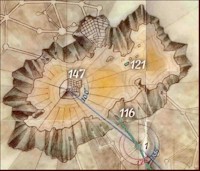
The D'ni cavern is roughly circular, but it has a longer axis running from the northeast to the southwest and a shorter axis from the northwest to the southeast. The largest island in the cavern is Ae'gura, and is the location of the political and religious center of the D'ni city. Ae'gura could be thought of as "downtown D'ni" in a sense. Aitrus, father of Gehn and grandfather of Atrus, drew a sketch of it on his map of the route they were excavating to the surface near the time of the Fall. He was an apprentice with the Guild of Surveyors at the time. That map is not a very accurate rendition of the cavern, since he was more concerned with the route than with the cavern itself. |
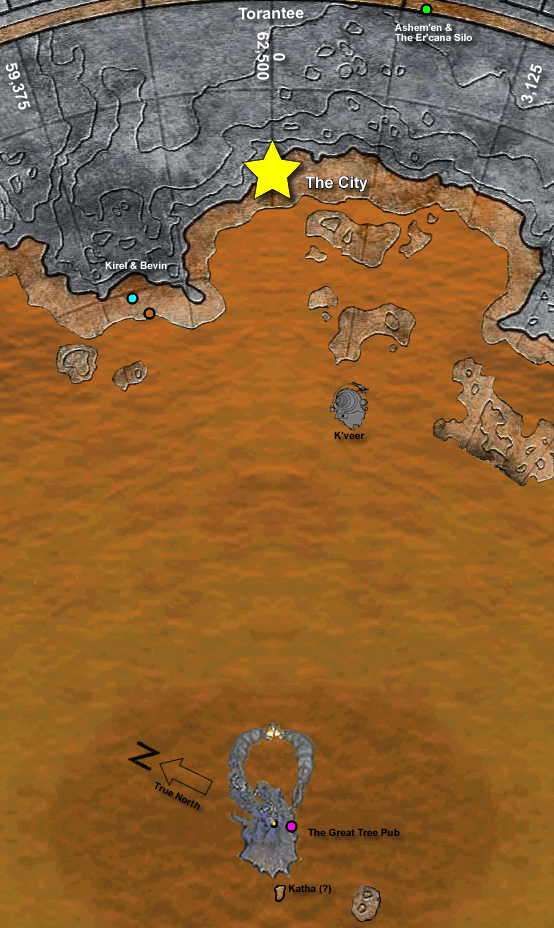
When the D'ni began to move into the cavern, the first group to arrive after a maintainer party determined its safety was a party from the Guild of Surveyors, who determined where magnetic north was at the time and aligned the zero meridian of the age along it, placing the center mark on the highest stalagmite of Ae'gura Island. That stalagmite was claimed to be three hundred and fifty shahfeetee tall, which is about 9/10ths of a mile (It isn't. Ki coordinates taken from the Ferry Terminal show it's ninety-three shahfeetee below the Great Zero). The zero line designating north was considered important, and all religious and government buildings were to be constructed on or near it.
The official line begins at the Great Zero, as the marker came to be called by the DRC, and runs down the center of the Great Stair and passes through Kerath's Arch. There is a strip of tile mosaic that begins in the Guild Hall complex and runs down most of the Great Stairs to show the line. The tile pattern on the strip is a design meant to represent the Great Tree of Possibilities.
The line was a subject of controversy in the course of D'ni history. It was based on magnetic north at the time of the founding of D'ni, and that planted the seed of the problem. Magnetic north and south are subject to change over the course of time, a phenomenon called polar drift. Magnetic north and south have even switched polarity several times since the formation of the Earth. A web site called Wolfram Alpha, which calculates polar drift, shows that when D'ni was founded in 7657 BC, magnetic north for Eddy County was about 61.94° east of true north, which is east by northeast on modern compasses. By the time of the Fall in DE 9400, it had shifted to 29.46° east of true north.
This allowed King Me'erta an excuse in DE 1817 (5840 BCE). He favored a cult named the Temple of the Tree and wanted to change the zero meridian so that it pointed at their temple, giving them an automatic degree of legitimacy. With that in mind, he advocated a change of the official zero line to 61.49° east of true north , which he would not have been able to do without polar drift muddying the waters. Me'erta argued that the line should have been set to a permanent feature such as a major landmark, and his proposed new zero meridian, which ran along the western side of the Great Library Courtyard, pointed to a prominent landmark that "just happened" to be very close to the cult temple.
Of course, King Me'erta didn't tell anyone that his real reason for wanting a new line was so that he could authorize religious cults to build temples along it, but in the end it didn't matter; the change was never officially adopted by the D'ni. It did confuse things sufficiently that his line is shown as the zero meridian on some maps of Ae'gura that I've seen. 1,295 years later, in DE 3112 (4545 BCE), King Rakeri finally resolved the problem by decreeing that the original zero line was the official one and that it should never be altered. By the time of his decree, magnetic north had shifted to 61.03° east of true north. (Just for the sake of knowing, at the time this article was written in AD2015, magnetic north was 7.47° east of true north.)
Note on the map that Me'erta's proposed line was only a few degress off from True North. The D'ni had never been to the surface and did not know the direction of Polar north and south, so that's just a rather interesting coincidence.
The map was made by the site master using the Great Zero Courtyard mosaic as its base, and is much more accurate than Aitrus' map. The directions and distances to various locations marked on it were taken from KI navigation readings. The only exception is Katha, which had to be placed in a general area mentioned by a person with restricted access to a map that shows where it is. The shape of Katha on this map is not accurate, since there is no image of it available. This is a section from a much larger map, which you can see by clicking on it.
Ae'gura island is shown near the bottom of the map, and K'veer is about three-quarters of the way between it and the coastline. The city is represented by the yellow star. The blue dot is the location of Kirel. The brown dot is the location of Bevin. The purple dot is the location of the Great Tree Pub and the part of J'taeri that surrounds it. The green dot is where the Er'cana Silo and the Ashem'en industrial district are located, and they are probably in another cave, since their coordinates are lower than the water level in the main cavern. |
Natural Influences
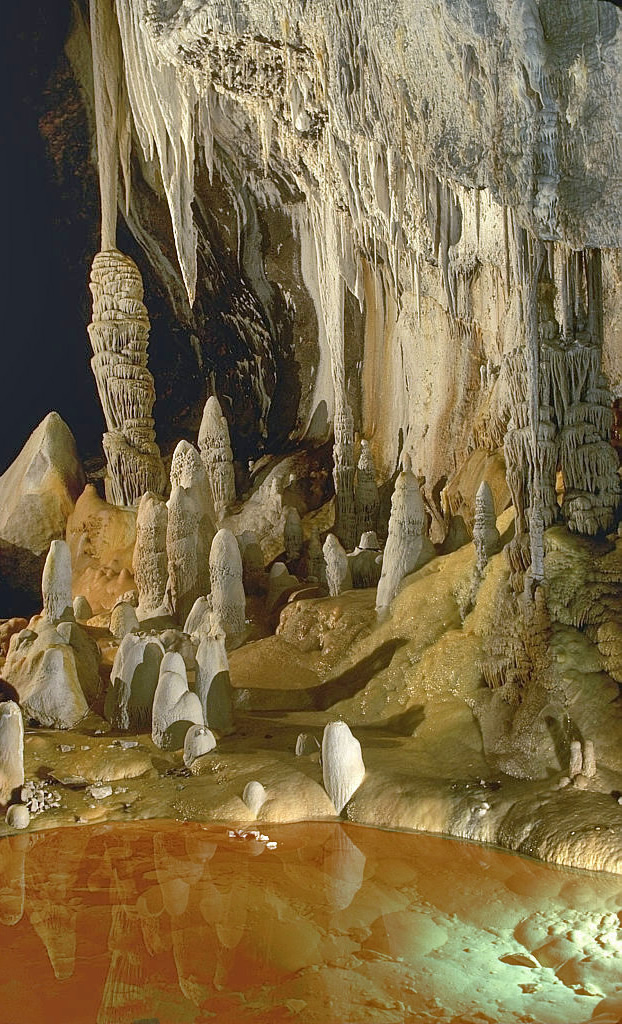 The D'ni used a number of designs based on natural features found in the cave system. Here is a picture of flowstone concretions in a nearby cave. You should be able to see a number of rock elements that the D'ni used for inspiration in their tilework, metalwork, and a few architectural designs. The D'ni used a number of designs based on natural features found in the cave system. Here is a picture of flowstone concretions in a nearby cave. You should be able to see a number of rock elements that the D'ni used for inspiration in their tilework, metalwork, and a few architectural designs.
|
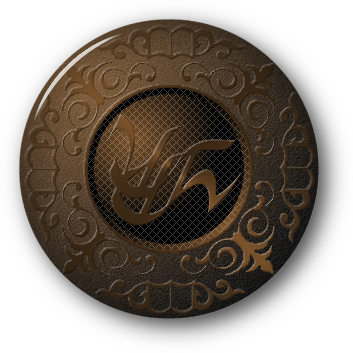

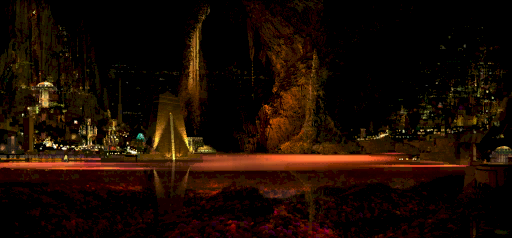


 The D'ni used a number of designs based on natural features found in the cave system. Here is a picture of flowstone concretions in a nearby cave. You should be able to see a number of rock elements that the D'ni used for inspiration in their tilework, metalwork, and a few architectural designs.
The D'ni used a number of designs based on natural features found in the cave system. Here is a picture of flowstone concretions in a nearby cave. You should be able to see a number of rock elements that the D'ni used for inspiration in their tilework, metalwork, and a few architectural designs.